中国书法绘画和建筑艺术【英文】 Chinese Calligraphy Painting and Architecture
- 格式:ppt
- 大小:14.67 MB
- 文档页数:22
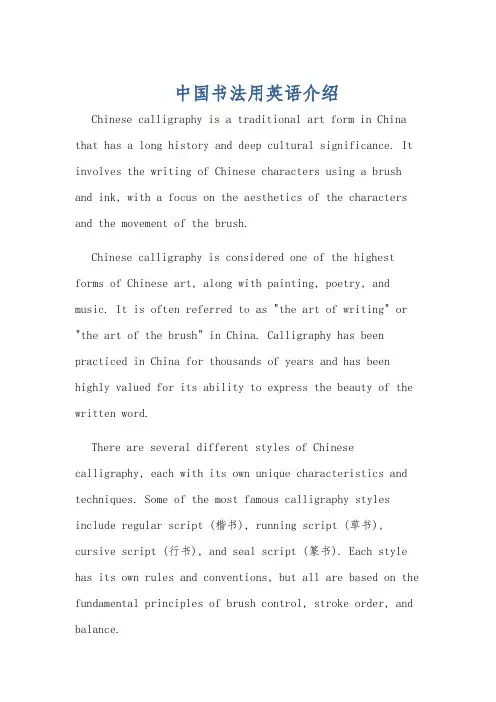
中国书法用英语介绍Chinese calligraphy is a traditional art form in China that has a long history and deep cultural significance. It involves the writing of Chinese characters using a brush and ink, with a focus on the aesthetics of the characters and the movement of the brush.Chinese calligraphy is considered one of the highest forms of Chinese art, along with painting, poetry, and music. It is often referred to as "the art of writing" or "the art of the brush" in China. Calligraphy has been practiced in China for thousands of years and has been highly valued for its ability to express the beauty of the written word.There are several different styles of Chinese calligraphy, each with its own unique characteristics and techniques. Some of the most famous calligraphy styles include regular script (楷书), running script (草书), cursive script (行书), and seal script (篆书). Each style has its own rules and conventions, but all are based on the fundamental principles of brush control, stroke order, and balance.One of the key elements of Chinese calligraphy is the use of brush strokes to create expressive and dynamic characters. Calligraphers pay close attention to the thickness, speed, and direction of each stroke, as well as the overall composition of the characters on the page. The result is a work of art that not only conveys the meaning of the text but also embodies the emotions and intentions of the calligrapher.In addition to its artistic value, Chinese calligraphyis also highly regarded for its cultural and spiritual significance. Calligraphy is often used in traditional Chinese ceremonies and rituals, such as weddings, funerals, and the Lunar New Year. It is also considered a form of meditation and self-expression, allowing practitioners to cultivate mindfulness and focus through the practice of writing.Overall, Chinese calligraphy is a rich and complex art form that reflects the beauty, history, and cultural heritage of China. It continues to be practiced and appreciated by people around the world, serving as a bridge between past and present, tradition and modernity.中国书法是中国传统艺术形式之一,具有悠久的历史和深厚的文化内涵。
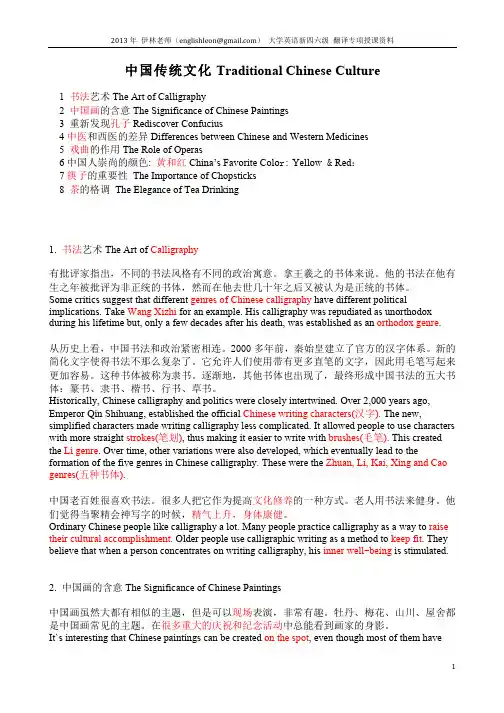
中国传统文化Traditional Chinese Culture1 书法艺术The Art of Calligraphy2 中国画的含意The Significance of Chinese Paintings3 重新发现孔子Rediscover Confucius4中医和西医的差异Differences between Chinese and Western Medicines5 戏曲的作用The Role of Operas6中国人崇尚的颜色:黄和红China’s Favorite Colo r: Yellow & Red:7筷子的重要性The Importance of Chopsticks8 茶的格调The Elegance of Tea Drinking1. 书法艺术The Art of Calligraphy有批评家指出,不同的书法风格有不同的政治寓意。
拿王羲之的书体来说。
他的书法在他有生之年被批评为非正统的书体,然而在他去世几十年之后又被认为是正统的书体。
Some critics suggest that different genres of Chinese calligraphy have different political implications. Take Wang Xizhi for an example. His calligraphy was repudiated as unorthodox during his lifetime but, only a few decades after his death, was established as an orthodox genre.从历史上看,中国书法和政治紧密相连。
2000多年前,秦始皇建立了官方的汉字体系。
新的简化文字使得书法不那么复杂了。
它允许人们使用带有更多直笔的文字,因此用毛笔写起来更加容易。

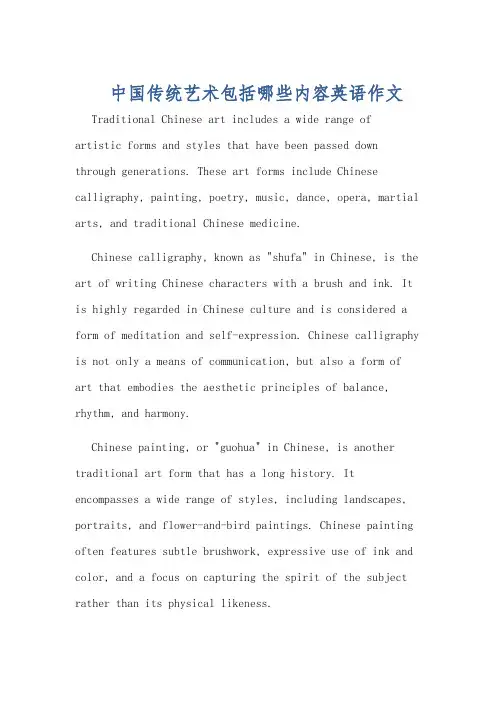
中国传统艺术包括哪些内容英语作文Traditional Chinese art includes a wide range ofartistic forms and styles that have been passed down through generations. These art forms include Chinese calligraphy, painting, poetry, music, dance, opera, martial arts, and traditional Chinese medicine.Chinese calligraphy, known as "shufa" in Chinese, is the art of writing Chinese characters with a brush and ink. It is highly regarded in Chinese culture and is considered a form of meditation and self-expression. Chinese calligraphy is not only a means of communication, but also a form ofart that embodies the aesthetic principles of balance, rhythm, and harmony.Chinese painting, or "guohua" in Chinese, is another traditional art form that has a long history. It encompasses a wide range of styles, including landscapes, portraits, and flower-and-bird paintings. Chinese painting often features subtle brushwork, expressive use of ink and color, and a focus on capturing the spirit of the subject rather than its physical likeness.Traditional Chinese poetry, or "shi" in Chinese, is characterized by its use of strict forms and intricate rhyme schemes. Classical Chinese poetry often conveys deep emotions and profound philosophical insights through its concise and elegant language.Traditional Chinese music includes a wide variety of instruments and styles, such as the guqin, pipa, erhu, and traditional Chinese opera. Chinese music is known for its melodic and rhythmic intricacy, as well as its ability to evoke a wide range of emotions and moods.Chinese dance, often performed in traditional Chinese opera, is characterized by its graceful and expressive movements, as well as its vibrant costumes and props. Traditional Chinese dance often tells a story or conveys symbolic meanings through its movements and gestures.Traditional Chinese opera, or "xiqu" in Chinese, is a comprehensive art form that combines music, singing, dialogue, acrobatics, and martial arts. It encompasses various regional styles, such as Peking opera, Cantonese opera, and Sichuan opera, each with its own unique performance techniques and repertoire.Traditional Chinese martial arts, or "wushu" in Chinese, are a diverse range of combat styles that have beenpracticed for self-defense, physical fitness, and spiritual development. Chinese martial arts emphasize the cultivation of internal energy, or "qi," as well as the development of mental discipline and ethical values.Traditional Chinese medicine, or "zhongyi" in Chinese,is a holistic system of healthcare that has been practiced for thousands of years. It includes various therapeutic modalities, such as acupuncture, herbal medicine, massage, and qigong, which are based on the principles of yin and yang, the five elements, and the meridian system.中国传统艺术包括了各种各样的艺术形式和风格,它们代代相传。
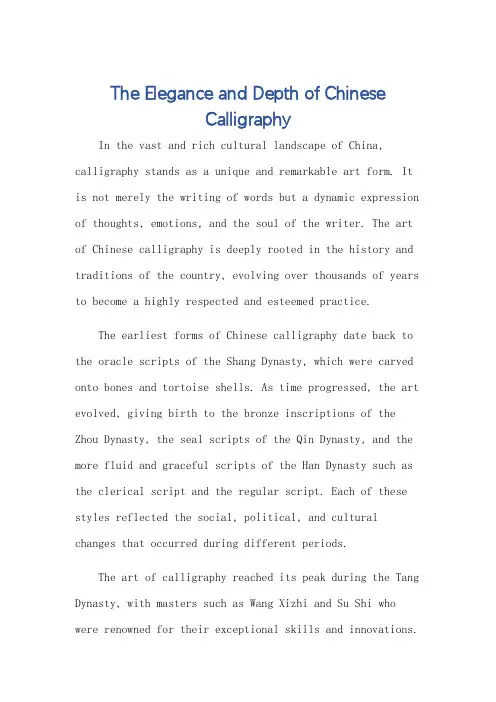
The Elegance and Depth of ChineseCalligraphyIn the vast and rich cultural landscape of China, calligraphy stands as a unique and remarkable art form. It is not merely the writing of words but a dynamic expression of thoughts, emotions, and the soul of the writer. The art of Chinese calligraphy is deeply rooted in the history and traditions of the country, evolving over thousands of years to become a highly respected and esteemed practice.The earliest forms of Chinese calligraphy date back to the oracle scripts of the Shang Dynasty, which were carved onto bones and tortoise shells. As time progressed, the art evolved, giving birth to the bronze inscriptions of the Zhou Dynasty, the seal scripts of the Qin Dynasty, and the more fluid and graceful scripts of the Han Dynasty such as the clerical script and the regular script. Each of these styles reflected the social, political, and cultural changes that occurred during different periods.The art of calligraphy reached its peak during the Tang Dynasty, with masters such as Wang Xizhi and Su Shi who were renowned for their exceptional skills and innovations.Their works were not only admired for their beauty but also for the profound philosophical and moral insights they conveyed. Calligraphy was often used as a medium to express one's thoughts and feelings, making it a powerful form of self-expression.The tools of calligraphy are as essential as the skill of the writer. The brush, ink, paper, and inkstone are the four treasures of the study, each playing a crucial role in creating the desired effect. The brush, with its varying degrees of softness and firmness, allows the writer to create strokes of different thicknesses and textures. The ink, with its varying shades and intensities, adds depth and dimension to the work. The paper, with its unique texture and absorbency, complements the brushstrokes, while the inkstone is used to grind the ink into the desired consistency.The practice of calligraphy requires immense patience, dedication, and skill. It is not just about writing words but about creating a harmonious composition that flows seamlessly from one stroke to another. Each stroke, eachcharacter, is carefully crafted, reflecting the writer's personality, mood, and emotional state.The beauty of Chinese calligraphy lies not only in its visual appeal but also in its ability to evoke deep emotional and intellectual responses. It is a form of art that transcends language and cultural barriers, connecting people across the globe through the universal language of beauty and expression.As we delve deeper into the world of Chinese calligraphy, we discover that it is not just a skill but a way of life. It embodies the essence of Chinese culture, reflecting its values, traditions, and beliefs. It teaches us about the importance of discipline, patience, and the pursuit of excellence. It reminds us that true beauty lies not in the外在形式 of things but in the内在spirit and soul that they embody.In conclusion, Chinese calligraphy is not just an art form; it is a way of life. It is a powerful medium of expression that allows us to connect with our inner selves and express our thoughts and feelings in a unique and profound manner. It is a testament to the rich culturalheritage of China and a gift that has been passed down through generations for us to cherish and appreciate.**中国书法艺术的优雅与深度**在中国丰富多彩的文化景观中,书法作为一种独特且引人注目的艺术形式而崭露头角。
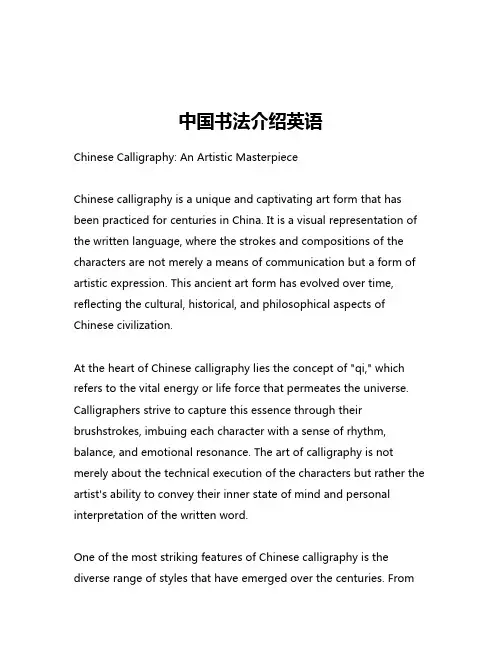
中国书法介绍英语Chinese Calligraphy: An Artistic MasterpieceChinese calligraphy is a unique and captivating art form that has been practiced for centuries in China. It is a visual representation of the written language, where the strokes and compositions of the characters are not merely a means of communication but a form of artistic expression. This ancient art form has evolved over time, reflecting the cultural, historical, and philosophical aspects of Chinese civilization.At the heart of Chinese calligraphy lies the concept of "qi," which refers to the vital energy or life force that permeates the universe. Calligraphers strive to capture this essence through their brushstrokes, imbuing each character with a sense of rhythm, balance, and emotional resonance. The art of calligraphy is not merely about the technical execution of the characters but rather the artist's ability to convey their inner state of mind and personal interpretation of the written word.One of the most striking features of Chinese calligraphy is the diverse range of styles that have emerged over the centuries. Fromthe bold and commanding "Kaishu" (regular script) to the fluid and expressive "Xingshu" (cursive script), each style reflects the unique aesthetic sensibilities and personal preferences of the calligrapher. The choice of script, the thickness and rhythm of the strokes, and the overall composition of the characters all contribute to the distinct character of a calligraphic work.The materials used in Chinese calligraphy are equally significant. The traditional tools include the brush, ink, paper, and inkstone, each of which plays a crucial role in the creative process. The brush, in particular, is an extension of the calligrapher's hand, allowing them to effortlessly manipulate the ink and create a wide range of expressive strokes. The quality of the paper, with its subtle textures and absorbent properties, also influences the final outcome, as it interacts with the ink to produce unique visual effects.The practice of Chinese calligraphy is not merely a technical exercise but a deeply introspective and spiritual process. Calligraphers often engage in meditative practices to cultivate a calm and focused state of mind, which is then reflected in the fluidity and harmony of their brushstrokes. The act of creating a calligraphic work is seen as a journey of self-discovery, where the artist's personal experiences, emotions, and philosophical beliefs are woven into the fabric of the artwork.Beyond its aesthetic appeal, Chinese calligraphy also serves as a window into the rich cultural heritage of China. The evolution of calligraphic styles is closely tied to the development of Chinese literature, history, and social customs. Each dynasty and region has its own distinctive calligraphic traditions, reflecting the unique cultural influences and artistic preferences of the time.In recent years, Chinese calligraphy has gained increasing global recognition, with artists and enthusiasts around the world exploring and appreciating this captivating art form. Contemporary calligraphers have also embraced new mediums and techniques, blending traditional practices with modern sensibilities to create innovative and thought-provoking works.In conclusion, Chinese calligraphy is a profound and multifaceted art form that continues to captivate and inspire audiences worldwide. From its deep-rooted cultural significance to its mesmerizing visual aesthetics, this ancient art form is a testament to the enduring creativity and spiritual essence of the Chinese people. Whether one is a seasoned connoisseur or a curious newcomer, the world of Chinese calligraphy offers a rich and rewarding journey of discovery and appreciation.。

我最爱的中国传统艺术形式书画英语作文全文共3篇示例,供读者参考篇1My Favorite Chinese Traditional Art Form: Chinese Calligraphy and PaintingChinese calligraphy and painting are two of my most beloved forms of traditional Chinese art. Both of these art forms have a long history in China and have deeply influenced Chinese culture and aesthetics.Chinese calligraphy, also known as “shufa” in Chinese, is the art of writing Chinese characters with a brush and ink. Calligraphy has been considered a high art form in China for thousands of years and is considered one of the four treasures of Chinese study, along with painting, poetry, and music. Chinese calligraphy is highly esteemed for its beauty, elegance, and expressions of the artist's emotions and personality. Each stroke in Chinese calligraphy is carefully crafted and conveys a sense of harmony, balance, and rhythm. By mastering calligraphy, one can appreciate the beauty of Chinese characters and the art of writing.Chinese painting, also known as “shuhua” in Chinese, is another significant art form that has been practiced in China for centuries. Traditional Chinese painting primarily uses brush and ink to depict landscapes, animals, flowers, and other subjects. Chinese painting emphasizes the artist's mastery of brushwork, composition, and ink techniques. The most famous Chinese painting styles include gongbi (meticulous) and xieyi (freehand). Chinese painting is valued for its simplicity, elegance, and ability to capture the essence of a subject with minimal brushstrokes.Both Chinese calligraphy and painting reflect the philosophies and aesthetics of traditional Chinese culture. They emphasize the interconnectedness of nature, art, and human emotions. Chinese calligraphy and painting require discipline, patience, and dedication to master, but the rewards are immense. By studying and practicing Chinese calligraphy and painting, one can gain a deeper understanding of Chinese culture, history, and artistic traditions.In conclusion, Chinese calligraphy and painting are two of my most cherished forms of traditional Chinese art. They embody the beauty, elegance, and richness of Chinese culture and are essential to the preservation and promotion of traditional Chinese art forms. I am deeply grateful for theopportunity to experience and appreciate the beauty and artistry of Chinese calligraphy and painting.篇2One of my favorite traditional Chinese art forms is calligraphy and painting. Both calligraphy and painting have a long history in China and are considered essential forms of artistic expression.Calligraphy, also known as “shufa” in Chinese, is a form of writing that emphasizes the beauty of the characters. Chinese calligraphy has a deep cultural significance and is often viewed as a way to reflect one’s personality and emotions. The brush strokes are carefully crafted to create an aesthetic and harmonious composition. Each stroke is deliberate and can convey different meanings and emotions. Calligraphy has been practiced in China for thousands of years and has been passed down through generations. It is considered one of the highest forms of art in Chinese culture.Painting, on the other hand, is another traditional Chinese art form that is closely related to calligraphy. Chinese painting often depicts landscapes, nature, animals, and figures. The brush and ink techniques used in Chinese painting are similar tocalligraphy, with an emphasis on the fluidity and expressiveness of the brushstrokes. Chinese paintings are known for their simplicity, elegance, and attention to detail. The use of colors and composition in Chinese painting is also significant, with artists often focusing on capturing the essence and spirit of the subject rather than creating a realistic representation.I am particularly drawn to Chinese calligraphy and painting because of the rich cultural heritage and artistic tradition they represent. The beauty and grace of the brush strokes, the intricate details, and the history behind each character or painting all contribute to the allure of these art forms. The meditative process of practicing calligraphy and painting also allows me to immerse myself in the art and connect with Chinese culture on a deeper level.In conclusion, Chinese calligraphy and painting are two of my favorite traditional art forms because of their beauty, cultural significance, and expressive qualities. They are not only a reflection of Chinese artistic heritage but also a way for me to appreciate and connect with the rich cultural traditions of China.I will continue to explore and immerse myself in the world of Chinese calligraphy and painting, as they continue to inspire and captivate me with their timeless beauty and elegance.篇3One of my favorite traditional Chinese art forms is calligraphy and painting, also known as shuhua in Chinese. This ancient art form has a long history in China and is deeply rooted in Chinese culture and traditions. As a lover of art and history, I have always been fascinated by the beauty and elegance of Chinese calligraphy and painting.Calligraphy, known as shufa in Chinese, is the art of writing Chinese characters with a brush and ink. It has been practiced in China for thousands of years and is considered one of the highest forms of Chinese art. Chinese calligraphy is not just about writing characters, but also about expressing the emotions and personality of the artist. Each stroke of the brush is carefully executed, and the overall composition reflects the artist's skill and creativity.Painting, known as huapai in Chinese, is another important traditional art form in China. Chinese painting is characterized by its use of vivid colors, intricate brushwork, and attention to detail. Traditional Chinese paintings often depict landscapes, flowers, birds, and other natural scenes. They are known for their poetic and ethereal quality, capturing the beauty and essence of the natural world.One of the things I love most about Chinese calligraphy and painting is the sense of tranquility and harmony they inspire. When I watch a calligrapher or painter at work, I am struck by the focus and concentration they bring to their art. There is a sense of mindfulness and presence that comes through in every brushstroke, and I find it deeply calming and meditative.In addition to the aesthetic beauty of Chinese calligraphy and painting, I also appreciate the cultural and historical significance of these art forms. They have played a central role in Chinese culture for centuries, influencing literature, philosophy, and even politics. Chinese calligraphy and painting are not just art forms, but reflections of Chinese values and ideals.Overall, Chinese calligraphy and painting hold a special place in my heart. Their beauty, history, and cultural significance make them truly unique and inspiring art forms. As I continue to deepen my understanding and appreciation of Chinese art, I am grateful for the opportunity to explore and experience the richness of this timeless tradition.。
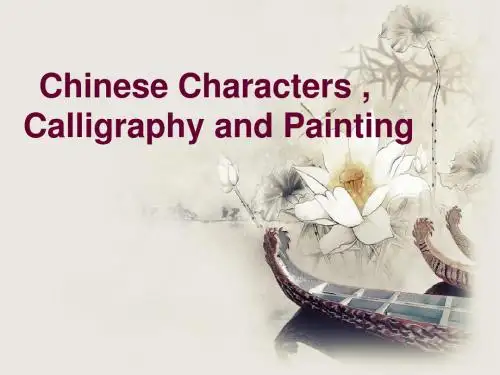

向外国人介绍书法艺术的英语作文Introduction to Chinese CalligraphyChinese calligraphy is an ancient and traditional art form that has been practiced for thousands of years in China. It is considered one of the highest forms of Chinese visual art and is deeply rooted in Chinese culture and history. In this essay, I will introduce you to the art of Chinese calligraphy and its significance in Chinese culture.History of Chinese CalligraphyChinese calligraphy has a long and rich history that dates back to ancient China. It originated as a form of writing and communication and eventually evolved into an art form. The earliest examples of Chinese calligraphy date back to the Shang dynasty (1600-1046 BC) and have been found on oracle bones and bronze vessels. Over the centuries, Chinese calligraphy has developed into a highly refined and stylized art form that is admired for its beauty, elegance, and expressiveness.Tools and TechniquesThe tools used in Chinese calligraphy are simple but essential. The four basic tools are the brush, ink, paper, and inkstone. The brush is usually made of animal hair (such as goat,wolf, or weasel) and can vary in size and shape. The ink is made from soot and water and is ground on an inkstone until it reaches the desired consistency. Chinese calligraphy is typically done on rice paper or silk, which are both absorbent materials that allow the ink to flow smoothly.There are five basic styles of Chinese calligraphy, each with its own unique characteristics and techniques. These styles are seal script (zhuanshu), clerical script (lishu), regular script (kaishu), running script (xingshu), and cursive script (caoshu). Each style has its own rules and conventions, but the essence of Chinese calligraphy lies in the artist's ability to express emotion, personality, and creativity through their brushstrokes.Significance in Chinese CultureChinese calligraphy holds a special place in Chinese culture and is regarded as a symbol of traditional Chinese values and aesthetics. It is often considered a reflection of the artist's character and spiritual cultivation, as each brushstroke is believed to reveal the artist's innermost thoughts and emotions. Chinese calligraphy is also associated with Confucianism, Taoism, and Buddhism, and is seen as a form of meditation andself-expression.In China, calligraphy is not only appreciated for its artistic value but is also used in various aspects of daily life. It is commonly seen on traditional Chinese paintings, scrolls, pottery, architecture, and even signage. Chinese calligraphy is also used in poetry, literature, philosophy, and as a means of personal expression and communication. It is a highly respected and revered art form that is passed down from generation to generation and is considered an essential part of Chinese cultural heritage.ConclusionIn conclusion, Chinese calligraphy is a unique and fascinating art form that has been cherished and celebrated in China for thousands of years. It is a reflection of Chinese culture, history, and philosophy and is admired for its beauty, elegance, and expressiveness. Whether you are a beginner or an expert, Chinese calligraphy offers a rewarding and enriching experience that can deepen your understanding of Chinese culture and history. So, why not pick up a brush, dip it in ink, and start exploring the world of Chinese calligraphy today?。
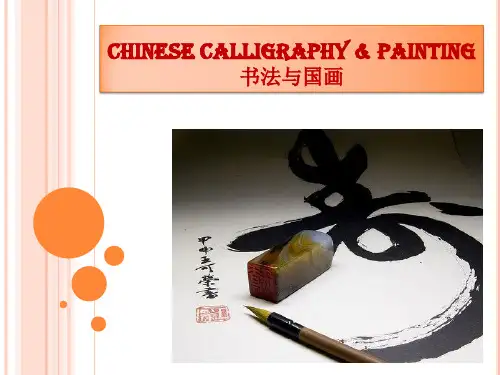
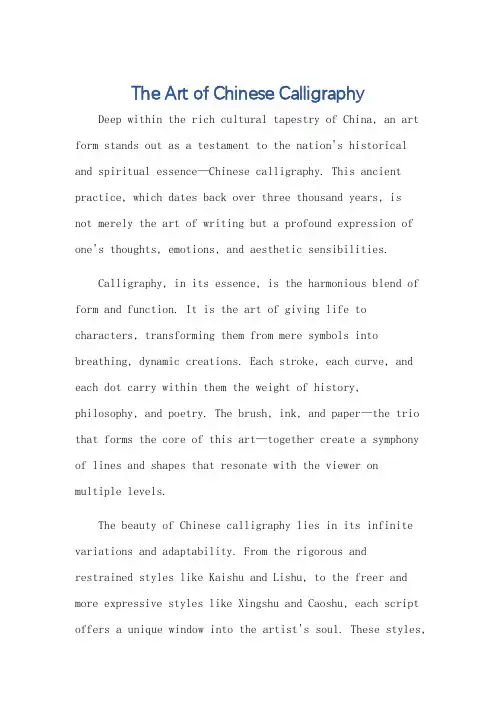
The Art of Chinese CalligraphyDeep within the rich cultural tapestry of China, an art form stands out as a testament to the nation's historical and spiritual essence—Chinese calligraphy. This ancient practice, which dates back over three thousand years, isnot merely the art of writing but a profound expression of one's thoughts, emotions, and aesthetic sensibilities.Calligraphy, in its essence, is the harmonious blend of form and function. It is the art of giving life to characters, transforming them from mere symbols into breathing, dynamic creations. Each stroke, each curve, and each dot carry within them the weight of history, philosophy, and poetry. The brush, ink, and paper—the trio that forms the core of this art—together create a symphony of lines and shapes that resonate with the viewer onmultiple levels.The beauty of Chinese calligraphy lies in its infinite variations and adaptability. From the rigorous andrestrained styles like Kaishu and Lishu, to the freer and more expressive styles like Xingshu and Caoshu, each script offers a unique window into the artist's soul. These styles,in turn, reflect the changing times and social moods, offering a glimpse into the rich history and culture of China.The mastery of calligraphy requires years of diligent practice and a deep understanding of the principles of balance, rhythm, and harmony. The artist must possess not only technical proficiency but also a keen aesthetic sensibility. The process of creating a calligraphic work is both meditative and expressive, allowing the artist to channel their thoughts and emotions into the ink and paper. Moreover, calligraphy is not just a visual art; it is also deeply connected to Chinese literature and philosophy. Many ancient poems, essays, and inscriptions were writtenin calligraphy, making it a crucial part of the literary heritage of China. The practice of calligraphy is also believed to cultivate one's moral character and refineone's spirit, making it a valuable tool for personal growth and enlightenment.In modern times, while the practical use of calligraphy has diminished with the advent of digital technology, its aesthetic value and cultural significance have remainedintact. Calligraphy is still widely appreciated and practiced, not only in China but also across the globe, as a unique form of artistic expression that transcends language and cultural barriers.In conclusion, Chinese calligraphy is not just an art; it is a living, breathing tradition that encapsulates the essence of Chinese culture and spirit. It is a testament to the creativity and wisdom of the Chinese people and a powerful reminder of the beauty and depth that can be found in the simplest of acts—the art of writing.**中国书法的艺术**在中国丰富多彩的文化织锦中,有一种艺术形式以其对国家和民族历史与精神的见证而脱颖而出——那就是中国书法。
IntroductionChinese calligraphy (Brush calligraphy) is an art unique to Asian cultures. Shu (calligraphy), Hua (painting), Qin (a string musical instrument), and Qi (a strategic boardgame) are the four basic skills and disciplines of the Chinese literati.Regarded as the most abstract and sublime form of art in Chinese culture, "Shu Fa" (calligraphy) is often thought to be most revealing of one's personality. During the imperial era, calligraphy was used as an important criterion for selection of executives to the Imperial court. Unlike other visual art techniques, all calligraphy strokes are permanent and incorrigible, demanding careful planning and confident execution. Such are the skills required for an administrator / executive. While one has to conform to the defined structure of words, the expression can be extremely creative. To exercise humanistic imagination and touch under the faceless laws and regulations is also a virtue well appreciated.By controlling the concentration of ink, the thickness and adsorptivity of the paper, and the flexibility of the brush, the artist is free to produce an infinite variety of styles and forms. In contrast to western calligraphy, diffusing ink blots and dry brush strokes are viewed as a natural impromptu expression rather than a fault. While western calligraphy often pursue font-like uniformity, homogeneity of characters in one size is only a craft. To the artist, calligraphy is a mental exercise that coordinates the mind and the body to choose the best styling in expressing the content of the passage. It is a most relaxing yet highly disciplined exercise indeed for one's physical and spiritual well being. Historically, many calligraphy artists were well-known for their longevity.Brush calligraphy is not only loved and practiced by Chinese. Koreans and Japanese equally adore calligraphy as an important treasure of their heritage. Many Japanese schools still have the tradition of having a student contest of writing big characters during beginning of a new school year. A biannual gathering commemorating the Lanting Xu by Wang Xi Zhi (The most famous Chinese calligrapher in Jin dynasty, ) is said to be held ceremonially in Japan. There is a national award of Wang Xi Zhi prize for the best calligraphy artist. Not too long ago, Korean government officials were required to excel in calligraphy. The office of Okinawa governor still displays a large screen of Chinese calligraphy as a dominating decor.In the West, Picasso and Matisse are two artists who openly declared the influence by Chinese calligraphy on their works. Picasso once said tht if he was born a Chinese, he would have been a calligraphy artist rather than a painter.[This article has been requested by quite a few educational institutes for teaching purpose. To request permission of reproduction, please contact the author at: sllee@ ]Dr. Siu-Leung Lee, the author, is listed among the best calligraphy artists historically by:Tsing Hua University calligraphy webSiteTsing Hua University calligraphy website (another one).Dr. Siu-Leung Lee is author of all translation and calligraphy of Nickelodeon's animated series "Avatar". He is also honored to write the logo calligraphy of the entrance gate of a Chinese National Park.First edition (Apr 2002)Second edition (Sep 2004) Three printings. Sold out。
【英语作文】中国书法 Chinese Calligraphy
CalligraphyistheessenceofChineseculture,
whichhasdevelopedintoaspecialhigh-levelartapartfromsatisfyingthe
needsofdailywritingShops
withstrongcommercialatmospherewillgainsomeeleganceiftheyaredecorated
withsomequaintculturalcalligraphicworksAsakindofart
work,thewritingofcalligraphyisparticularThecalligraphyworksaremostlyapoemoramo ttothatthehostof
theroomlikesitmuch;ifitiswrittenbythehosthimself,itwill
demonstratemorehisaspirationandinterestaswellashistalent.
书法是中国文化的精粹,除了满足日常书写外,它已经上升成为一门特别的高等艺术。
他兴旺于中华大地数千年而不衰。
商业气息浓重的店面装饰一些具有古色古香、文化色彩
的书法作品就会平添几分高雅。
书法作品也常常装饰客厅,书房和卧室。
作为一种艺术,
书法的书写是很讲究的。
汉字写在吸水性很强的宣纸上,然后再装裱起来挂上墙壁。
书法
作品多半是居室主人所喜爱的一首诗词或是一句格言;如果这是他自己所作,那就更能显
示他的志趣和才华了。
感谢您的阅读,祝您生活愉快。